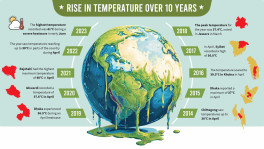Not wasting wastes: Lessons from the forests
There are many things that we can learn from the forests. Not wasting waste is one.

There are many things that we can learn from the forests. a single forest can sustain thousands of species of plants, animals and innumerable micro-organisms. In fact, 80 percent of all the terrestrial plant and animal species are found in the forests. One cannot but wonder how productive these places are. Yet, not only don't forests need external inputs except for natural ones like rain but also they do not create any landfill.
Now, let us look at the agricultural land around us. To produce a fair amount of grain, vegetables or any cash crop, one needs to prepare the land, apply fertiliser in multiple stages and on top of that use pesticides. Yet, the productivity of croplands only continue to decline over time, subsequently increasing the need for inputs.
The reason is simple. Whatever dies in a forest, becomes the food for other life forms, on which many other species of animals and plants rely. On the contrary, as crops grow in a piece of land, they take the nutrients from it and converts it into a form suitable for humans and other animals to consume. The inedible parts of the crops go somewhere else- either to be used in some application or landfills for decomposition.
The nutrients in the food grown in the fields go into human and other animal bodies, but unlike forests, hardly any part returns to the field, creating a resource scarcity in the crop fields.
Of course, there are instances of cow dung or green wastes being composted and being used as fertiliser, which is one of the few instances where we cyclically return something to the soil out of which we grow crops.
Human waste- urine and faeces- is also nutrient-rich, but we do not usually return them to the land due to a number of factors: lack of knowledge, and more significantly, because of the "eww-factor," which refers to the disgust towards human excreta. Also, unprocessed human faeces carry harmful pathogens, which is why it needs to be duly composted before added to croplands. Human urine, however, is almost always pathogen-free, unless the person urinating is ill from certain diseases.
Despite the inconveniences, small scale use of human waste can be seen in some places on earth. As the human race is becoming more aware of the growing ecological crisis the planet is facing due to anthropogenic activities, more and more communities and countries are adopting strategies conducive to returning nutrients to the soil in a more natural way.

Even in Bangladesh, turning both green waste and faecal sludge into compost manure is not anything new. Many initiatives have been taken over the years that saw various degrees of success.
But for the first time in the country, a local government body - Gazipur City Corporation (GCC)- is going to make compost manure from human waste in a centralised plant. GCC has signed an agreement with the International Financial Corporation (IFC) worth Tk700 crore with the goal of using human waste generated from more than 4 million people living in the City Corporation area to make fertiliser and manage waste at the same time.
According to a study jointly conducted by the University of Leeds, Bangladesh University of Engineering and Technology (BUET), International Water Management Institute (IWMI), and the NGO, Forum for Public Health, Bangladesh produces more than 80,000 metric tons of faecal waste every day. Almost all of it ends up in rivers, canals and wetlands without treatment, causing serious pollution.
Bangladesh for last few years has seen a number of big projects, often funded by top international financial institutes, under which more than a thousand kilometres of new drains have been constructed in semi-urban settings. These drains only add to the pre-existing water pollution as these high-budget projects did not care about installing any treatment facilities at the end of the drainage system. These "wastes" - or should we say wasted nutrients – are destroying the aquatic ecosystem in one hand, and depriving the soil of its food on the other.
According to the reports, Bangladesh currently uses about 50 lakh tonnes of chemical fertilisers every year, and three-fourths of this amount is imported costing about Tk15,000 crore. The government also has to provide more than Tk7000 crore of subsidy for fertilisers.
Human waste not only pollutes surface water but also contaminates ground water where waste is being piped deep underground by thoughtless individuals in the absence of a sewerage system.
Therefore, wasting human waste is a missed opportunity to protect the environment and return nutrients to the soil.
The abovementioned study, published in 2015, concluded that faecal sludge generated in Bangladesh can potentially meet up to 17 percent, 15 percent and 10 percent of the nitrogen, phosphorus and potassium requirements of the principal crops, respectively. The benefit to the aquatic ecosystem is also imaginable.
Another study concluded that human manure could completely substitute the import of fertilisers. The real potential can be determined by working more on such projects, but there is no doubt about the feasibility of it.
Apart from financial benefits and the protection of our immediate environment, composting human waste on a large scale to use for soil amendment has a far deeper significance.
This actually could be our first step into a circular economy - an economic system that aims at eliminating waste by reusing, repairing, and recycling. A circular economy is desirable in order to put an end to the traditional linear economy with a "take, make, dispose" model of production, which is leading to the unsustainable use of resources, pollution, destruction of biodiversity, and the creation of more and more landfills.
As mentioned in the onset, there are many things that we can learn from the forests. Not wasting waste is one.
The author is feature writer at The Business Standard


 Keep updated, follow The Business Standard's Google news channel
Keep updated, follow The Business Standard's Google news channel
















